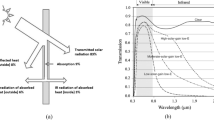Summary
Thermotropic glazings change their light transmittance from transparent to opaque upon reaching a certain threshold temperature reversibly. Such functional glazings can provide effective overheating protection for building façades or solar thermal collectors. The most promising thermotropic glazing materials consist of a continuous and discontinuous phase. Whereas the refractive indices of these two phases match perfectly at low temperatures, i.e. in the transparent state, a mismatch in refractive index above the threshold temperature causes the material to turn opaque. Besides the match/mismatch of refractive indices the overheating protection performance of the thermofunctional material is significantly affected by the size, concentration and distribution of the discontinuous phase. The overall objective of the present study is to produce tailor-made thermotropic overheating protection glazings by systematic material pre-selection and formulation. Specific focus is given to the establishment of a fundamental understanding of relationships between the material formulation and structural parameters and the light-shielding properties of thermotropic layers, based on sound principles of polymer physics and materials science. Prior to material formulation the components are characterized as to refractive index and phase transition temperatures. The produced thermotropic materials are analyzed as to solar optical properties in clear and opaque state, threshold temperature, switching process applying UV/Vis/NIR spectroscopy equipped with a heating stage. Whereas for some thermotropic glazings an increase of the hemispheric solar transmittance is ascertain upon reaching the threshold temperature, the most promising material formulations exhibit a hemispheric solar transmittance around 80 % in the clear state, which decreases to values around 60 % above the switching threshold. For the latter material types a distinct correlation between the refractive index data and the light-shielding efficiency is discernible. In general the materials are characterized by a steep and rapid switching process. The switching characteristics of the thermotropic layers showed an excellent correlation with thermal transitions of the discontinuous phase.
Zusammenfassung
Thermotrope Verglasungen gehen bei Erreichen einer bestimmten Temperatur selbsttätig und reversibel von einem transparenten, strahlungsdurchlässigen in einen opaken, reflektierenden Zustand über. Derartige Materialien können als Überhitzungsschutzelement in Gebäudeverglasungen oder solar-thermischen Kollektoren eingesetzt werden. Für derartige Anwendungen besonders aussichtsreiche thermotrope Materialien bestehen aus einer kontinuierlichen und einer diskontinuierlichen Phase. Während die Brechungsindizes beider Phasen im transparenten Zustand bei niedrigen Temperaturen gut übereinstimmen, kommt es oberhalb der Schalttemperatur zu einer reversiblen Eintrübung aufgrund des Brechungsindexunterschieds zwischen den Phasen. Neben dem Brechungsindexunterschied werden die Überhitzungsschutzeigenschaften der thermofunktionalen Materialien in entscheidender Weise vom Anteil, der Größe und der Verteilung der diskontinuierlichen Phase bestimmt. Im Rahmen der gegenständlichen Studie sollen ausgehend von einem systematischen Materialauswahl- und Formulierungsprozess maßgeschneiderte thermotrope Verglasungen für Überhitzungsschutzverglasungen hergestellt werden. Besonderes Augenmerk wird dabei auf den Aufbau eines fundierten Verständnisses über Zusammenhänge zwischen der Materialformulierung, morphologischer Parameter und den Überhitzungsschutzeigenschaften von thermotropen Schichten, unter besonderer Beachtung polymerphysikalischer und werkstoffkundlicher Aspekte gelegt. Die verwendeten Einsatzstoffe werden hinsichtlich Brechungsindex und thermischer Eigenschaften charakterisiert. Die thermotropen Schichten werden hinsichtlich ihrer solar optischen Eigenschaften im ungeschalteten und geschalteten Zu Zustand, Schalttemperatur sowie Schaltcharakteristik mittels temperaturgeführter UV/Vis/NIR Spektroskopie analysiert. Bei einigen thermotropen Materialien wird eine Zunahme der hemisphärischen solaren Transmission bei Erreichen der Schalttemperatur beobachtet. Die vielversprechendsten Schichten zeigen eine Reduktion der hemisphärischen Transmission von etwa 80 % im ungeschalteten Zustand auf etwa 60 % im geschalteten Zustand. Die Überhitzungsschutzeigenschaften dieser Materialien korrelieren exzellent mit den Brechungsindexdaten. Im Allgemeinen sind die Materialien durch einen raschen und steilen Schaltprozess gekennzeichnet. Die Schaltcharakteristik der thermotropen Schichten zeigt eine ausgezeichnete Korrelation mit thermischen Übergängen der diskontinuierlichen Phase.
Similar content being viewed by others
Literaturverzeichnis
Nitz, P., und Hartwig, H.: Solar Energy 79 (2005), S. 573–582
Seeboth, A., Schneider, J. und Patzak, A.: Solar Energy Materials and Solar Cells 60 (2000), S. 263–277
Wallner, G.M., Resch, K. und Hausner, R.: Solar Energy Materials and Solar Cells 92 (2008), S. 614–620
Resch, K. und Wallner, G.M.: Solar Energy Materials and Solar Cells 93 (2008), S. 119–128
Nitz, P.: Optische Modellierung und Vermessung thermotroper Systeme. PhD Thesis (1999), Fakultät für Physik, Albert-Ludwigs-Universität Freiburg im Breisgau
Luyt, A., Krupa, I., Assumption, H.J., Ahmad, E.E.M., Mofokeng, J.P.: Polymer Testing 29 (2010), S. 100–106
Author information
Authors and Affiliations
Corresponding author
Rights and permissions
About this article
Cite this article
Resch, K., Weber, A. Smart Windows – Smart Collectors: Entwicklung von funktionalen Überhitzungsschutzverglasungen für Gebäudeverglasungen und thermische Solarkollektoren. Berg Huettenmaenn Monatsh 156, 429–433 (2011). https://doi.org/10.1007/s00501-011-0031-2
Received:
Accepted:
Issue Date:
DOI: https://doi.org/10.1007/s00501-011-0031-2




